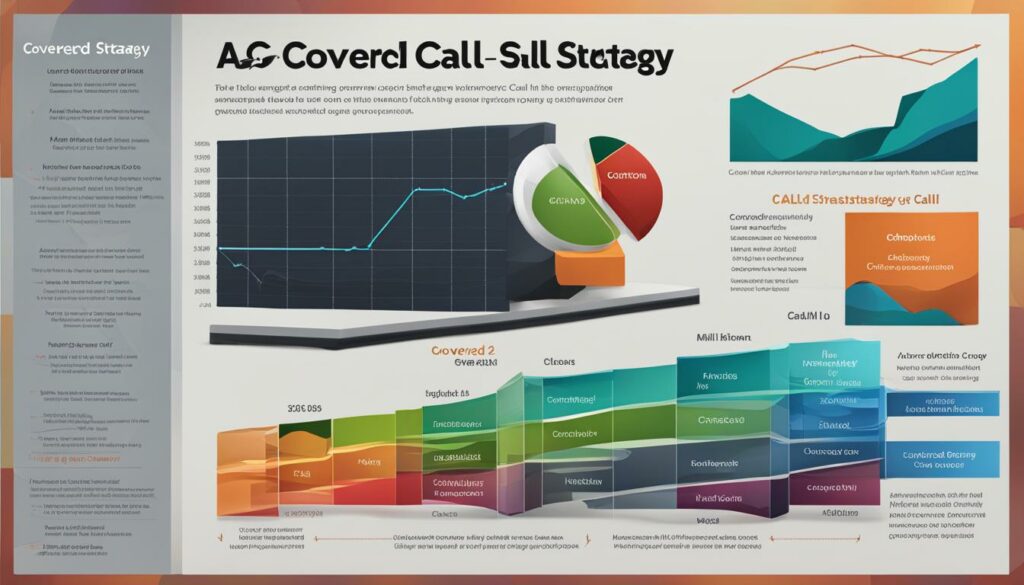The Covered Call Strategy: Selling Call Options When You Own The Underlying

A covered call is a popular options strategy where the investor sells call options on an underlying security they already own. This strategy allows the investor to generate income in the form of options premiums. Covered calls are often used when investors have a neutral view of the asset’s price movement and want to generate income while waiting for appreciation. This strategy is considered lower-risk as it requires the investor to own the underlying asset, providing a level of downside protection.
Key Takeaways:
- Covered calls involve selling call options on an underlying security the investor already owns.
- It allows for income generation through options premiums.
- This strategy is considered lower-risk as it requires ownership of the underlying asset.
- Covered calls are used when investors have a neutral view of the asset’s price movement.
- It provides a level of downside protection for the investor.
Understanding Covered Calls
Covered calls are a popular options strategy that investors employ to generate income while still holding the underlying stock for the long term. But what does ‘selling covered calls’ mean? It refers to the practice of selling call options on an underlying security that the investor already owns. This strategy is often used when investors have a neutral view of the asset’s price movement and want to benefit from collecting options premiums.
When implementing a covered call strategy, investors expect minor fluctuations in the price of the underlying stock. This means they believe the stock price will not significantly increase or decrease over the near term. By writing covered calls, investors can earn income in the form of premiums while still participating in potential stock appreciation. However, it’s essential to note that if the price of the stock moves above the strike price of the sold call options, the investor may miss out on additional stock gains.
“Selling covered calls allows investors to generate income while still holding the stock for potential long-term gains.”
Selling covered calls can be an attractive strategy for income generation. By collecting premiums from selling the options, investors can enhance their overall investment returns. It is important, however, for investors to consider their risk appetite and weigh the potential benefits against the risks involved. Understanding the fundamentals of covered calls is crucial for effectively implementing this options strategy.

Summary
- To execute a covered call, the investor must own the underlying asset and sell call options on that asset.
- Entering a covered call involves selling call options with a strike price above the current stock price.
- Exiting a covered call can be done by allowing the options to expire worthless or by buying back the options before expiration.
- Entering and exiting a covered call strategy requires careful consideration of the underlying asset’s price movement and the investor’s outlook on future price changes.
Risks and Benefits of Selling Covered Calls
Selling covered calls can provide investors with both risks and benefits. It’s important to carefully weigh these factors before implementing a covered call strategy.
Risks:
- Potential loss of stock gains: One risk of selling covered calls is the potential loss of stock gains if the price of the underlying asset moves above the strike price of the sold call options. When the stock price exceeds the strike price, the buyer of the call option may choose to exercise the option, resulting in the investor having to sell the stock at a lower price than the market value.
- Obligation to provide shares: As the seller of the call options, the investor is obligated to provide 100 shares of the underlying asset at the strike price if the buyer chooses to exercise the options. This can result in the investor having to sell the shares at a lower price than the market value.
Benefits:
- Income generation: Selling covered calls allows investors to generate income in the form of premiums. The premiums received from selling the options can enhance the return on investment and provide a consistent source of income.
- Risk management: By selling covered calls, investors can limit potential losses in an options transaction. The premiums collected from selling the options act as a cushion against potential downside risk.
Additionally, there may be possible tax advantages associated with selling covered calls. It’s important for investors to consult with a tax professional to fully understand these potential benefits.

The Impact of Market Factors on a Covered Call
Market factors play a crucial role in the success of a covered call strategy. Two significant factors to consider are time decay and implied volatility. Understanding how these factors influence a covered call trade is essential for effective execution and maximizing potential returns.
Time Decay and Its Impact
Time decay, also known as theta decay, refers to how the value of an option decreases as it approaches its expiration date. This is because the closer an option gets to expiration, the less time there is for the underlying asset to move in a favorable direction for the option holder. As a covered call writer, time decay can work in our favor. We collect the premium from selling the option, and as time passes, the option’s value diminishes, allowing us to keep the premium as profit.
By understanding the concept of time decay, we can strategically choose options with shorter expiration dates to capture more significant premium decay and increase our overall income generation. However, it’s crucial to strike a balance between maximizing premium decay and managing risk, as shorter-term options may also expose us to potential stock price movements.
Implied Volatility and Its Effect
Implied volatility is a measure of the market’s expectation for future price fluctuations of the underlying asset. Higher implied volatility translates to higher options premiums, and as covered call writers, this can work to our advantage. Selling call options during periods of elevated implied volatility allows us to collect more substantial premiums, boosting our income potential.
However, it’s vital to be cautious when navigating implied volatility, as heightened volatility can also indicate increased uncertainty and potential market turbulence. When implied volatility is low, premiums may be lower, but it may also signal a more stable market environment. Striking a balance between high implied volatility and risk management is crucial for successful covered call trading.
| Market Factor | Impact |
|---|---|
| Time Decay | Works in our favor as covered call writers, allowing us to collect premiums as options lose value over time |
| Implied Volatility | Higher implied volatility leads to higher premiums, increasing income potential, but requires careful risk management |
Understanding the impact of market factors on a covered call strategy is essential for making informed decisions. By leveraging time decay and implied volatility to our advantage and carefully assessing risk, we can enhance our income generation potential while managing downside exposure. As with any trading strategy, it’s important to stay informed, adapt to changing market conditions, and continually evaluate the effectiveness of our covered call approach.

| Original Covered Call | Rolled Covered Call |
|---|---|
| Underlying Asset: XYZ Stock | Underlying Asset: XYZ Stock |
| Current Stock Price: $50 | Current Stock Price: $50 |
| Original Call Option | New Call Option |
| Strike Price: $55 | Strike Price: $60 |
| Expiration Date: 30 days | Expiration Date: 60 days |
| Premium Received: $2 | New Premium: $1.50 |
Note: The example above is for illustrative purposes only and does not guarantee or imply any specific investment outcomes.
The Underlying Asset and Income Generation
In a covered call options strategy, the underlying asset refers to the security that the investor already owns and on which they write call options. By selling covered call options on the underlying asset, investors have the opportunity to generate income in the form of premiums. These premiums are received from the sale of the options and can significantly enhance the investor’s overall income, providing an attractive source of additional earnings.
When an investor sells a covered call option, they receive a premium from the buyer. This premium is essentially compensation for the potential obligation to provide 100 shares of the underlying asset at the specified strike price if the buyer chooses to exercise the option. The income generated from selling covered call options adds to the investor’s existing income streams, making it a valuable strategy for those looking to generate consistent returns.
For example, let’s say an investor owns 100 shares of XYZ Company. They decide to sell covered call options on these shares with a strike price of $50. If the options are sold for a premium of $2 per share, the investor will receive $200 in income. If the options expire worthless, the investor can keep the premium and continue to generate income by selling more covered call options in the future.
| Benefits of Selling Covered Call Options | Risks of Selling Covered Call Options |
|---|---|
|
|
By carefully evaluating the potential risks and benefits, investors can determine if selling covered call options aligns with their investment goals and risk tolerance. It is recommended to consult with a financial professional to fully understand the implications of this strategy and ensure it fits within an overall investment plan.
Risks Associated with Selling Covered Call Options
When considering the covered call options strategy, it’s important to be aware of the risks involved. One of the primary risks is the potential loss of stock gains if the price of the underlying asset moves above the strike price of the sold call options. This means that if the stock price significantly increases, the investor may miss out on potential profits beyond the strike price.
Another risk to consider is the impact of the underlying asset’s price movement on the success of the covered call options strategy. If the price of the asset does not move as anticipated, the strategy may not result in the desired profit. It’s essential for investors to closely monitor the price movement and adjust their strategy accordingly.
Additionally, like any investment strategy, there is always a certain degree of market risk associated with selling covered call options. Market conditions can fluctuate, impacting the overall performance of the strategy. It’s crucial to stay informed about market trends, volatility, and other factors that can affect the success of the strategy.

Table: Risks Associated with Selling Covered Call Options
| Risks | Description |
|---|---|
| Potential loss of stock gains | If the price of the underlying asset moves above the strike price of the sold call options, the investor may miss out on potential profits beyond the strike price. |
| Effect of the underlying asset’s price movement | The success of the covered call options strategy is dependent on the price movement of the underlying asset. If the price does not move as anticipated, the strategy may not result in the desired profit. |
| Market risk | Like any investment strategy, there is always a certain degree of market risk associated with selling covered call options. Market conditions can fluctuate, impacting the overall performance of the strategy. |
By carefully considering and managing these risks, investors can ensure they make informed decisions when implementing a covered call options strategy. It’s important to weigh the potential rewards against the risks involved and to continually monitor market conditions to make any necessary adjustments to the strategy.
Conclusion
The covered call options strategy is a powerful tool for income generation and risk management. By selling call options on an underlying asset that we already own, we can generate additional income in the form of premiums while providing a level of downside protection. This strategy is particularly useful for investors with a neutral view on the asset’s price movement over the near term.
However, it’s important to carefully consider the risks and benefits before implementing a covered call options strategy. While this approach offers reliable premiums and limits potential losses, there is the risk of missing out on stock gains if the price of the underlying asset exceeds the strike price of the sold call options. Additionally, the success of the strategy is dependent on the price movement of the underlying asset, so thorough analysis and monitoring are crucial.
For those seeking to further enhance their covered call options strategy, advanced techniques such as rolling covered calls can be employed. This involves closing out existing call options and opening new ones with different expiration dates or strike prices. Rolling covered calls can help adapt to changing market conditions, extending income-generating potential and adjusting the strategy as needed.
In conclusion, the covered call options strategy is a versatile approach that provides income generation and risk management opportunities. By understanding the risks and benefits, carefully analyzing market factors, and employing advanced techniques when appropriate, we can optimize our covered call options strategy for maximum effectiveness and profitability.
FAQ
What is a covered call strategy?
A covered call strategy is an options strategy where the investor sells call options on an underlying security they already own. This strategy allows the investor to generate income in the form of options premiums.
When is a covered call strategy typically used?
Covered calls are often used when investors have a neutral view of the asset’s price movement and want to generate income while waiting for appreciation. It is an ideal strategy for investors who believe the underlying price will not move significantly over the near term.
How does a covered call work?
To execute a covered call, the investor needs to hold a long position in an asset and then write (sell) call options on that same asset. The investor receives a premium for selling the options, but they are obligated to provide 100 shares at the strike price if the buyer chooses to exercise the option.
What are the benefits of selling covered calls?
One of the main benefits of selling covered calls is the ability to earn reliable premiums and limit potential losses in an options transaction. It can help to generate income and act as a risk management strategy.
What are the risks associated with selling covered calls?
One of the main risks is the potential loss of stock gains if the price of the underlying asset moves above the strike price of the sold call options. Additionally, the success of a covered call options strategy is dependent on the price movement of the underlying asset.
How do market factors impact a covered call strategy?
Market factors such as time decay and implied volatility can have an impact on the success of a covered call strategy. Time decay refers to the decrease in the option’s value as it approaches expiration, which can work in the covered call writer’s favor. Implied volatility refers to the market’s expectation of future price movement, which can result in higher options premiums.
What are some advanced covered call strategies?
One advanced strategy is rolling a covered call, which involves closing out an existing call option and simultaneously opening a new call option with a later expiration date or higher strike price. This strategy allows the investor to continue generating income while potentially benefiting from changes in the market.
What is the underlying asset in a covered call strategy?
The underlying asset in a covered call options strategy refers to the security that the investor owns and writes call options on. Selling covered call options on the underlying asset allows investors to generate income in the form of premiums.
What are the risks of selling covered call options?
The risks of selling covered call options include the potential loss of stock gains if the price moves above the option’s strike price and the obligation to provide 100 shares if the option is exercised. The success of the strategy is also dependent on the price movement of the underlying asset.







